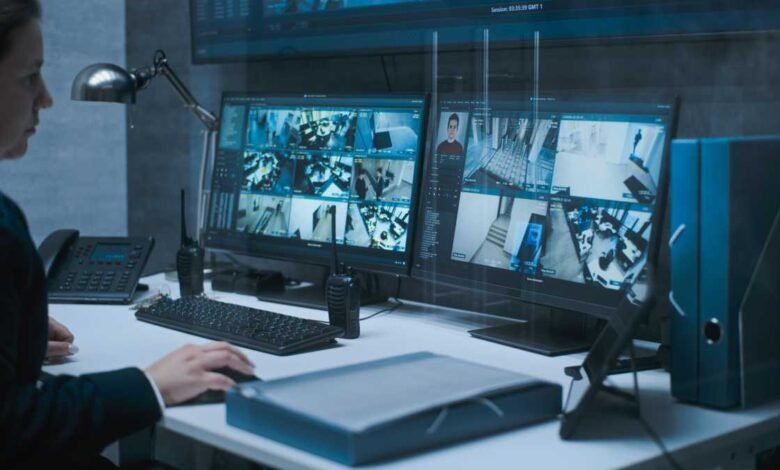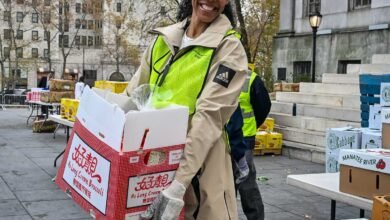Privacy group details extensive city-run surveillance in new report


A technology privacy group raised concerns over the extent that New York City agencies surveil the public in a report published Thursday, alleging the city’s surveillance network is dangerous and ineffective.
The report, led by the Surveillance Technology Oversight Project (STOP), argues facial recognition technology, camera networks and modern safety technology create a web of surveillance that threatens privacy and civil liberties. NYPD officials have long contended that surveillance is a key crime-fighting tool.
Titled “A People’s Handbook of Surveillance,” the report aimed to illustrate to the public the extent of surveillance across New York, said Lisa Berglund, a professor at Morgan State University studying policing, privacy and urban planning who co-authored the handbook.
“These technologies lack transparency by design; they have high rates of inaccuracy,” Berglund told amNewYork. “We wanted to invite local communities and everyday New Yorkers into a conversation about better understanding what the threats of these technologies are.”
New Yorkers face surveillance not only through widespread cameras and facial recognition technology, which the NYPD manages or can access, but also through non-police systems, such as OMNY (the tap-and-go subway system), mobile location data, Citi Bike terminals, license plate readers and doorbell cameras, according to the report.
Berglund said the data other city agencies collect contributes to the overall “surveillance state,” alongside police tracking.
“The main actors that are pointed to are usually NYPD or other law enforcement actors, but it really is a broad constellation of actors that come together, sometimes without awareness of exactly the threat that they are creating,” Berglund said.
To access non-police data, officers generally have to subpoena the data and have the request approved by a court.
Kayla Mamaluk, City Hall press secretary, said the city’s policing strategy has reduced crime by using the technology at its disposal.
“It’s the result of precision policing and strategically surging resources to the communities that need them most,” Mamaluk wrote to amNewYork. “Technology also plays a critical role in our operations — and we’ve implemented tools and practices that are not only legal and equitable, but — simply put — are effective at getting the bad guys off our streets and keeping good people safe.”
The handbook frames New York’s extensive surveillance system as a threat to political liberties because police and city agencies have the capability to track protesters or dissenters, effectively “chilling expression.”
Eleni Manis, STOP’s research director and handbook co-author, said surveilling protests “kills expression,” especially in communities of color that have experienced over-policing.
“When you have reason to believe that police may track you when you leave a protest, that they may well use surveillance footage to identify and keep an eye on protesters, there’s reason to fear protesting, especially if you are part of an over-policed community already,” Manis told amNewYork.
NYPD used facial recognition technology to identify some protesters at Black Lives Matter protests in 2020, according to a successful lawsuit brought by Amnesty International and STOP in 2022.
Other civil rights and legal organizations have raised the alarm on surveillance in New York City before, including the Brennan Center for Justice and the New York branch of the ACLU. And a New York Times investigation in 2023 found that the NYPD routinely uses counterterrorism tools to combat street crime.
Recurring debates on discrimination
The STOP report also emphasizes the alleged discrimination in surveillance technology, arguing police disproportionately surveil communities of color.
“There’s plenty of evidence that surveillance is used by police to target people of color, to harass people with criminal justice involvement, to target immigrants elsewhere in the country, to target people seeking abortion or gender affirming care, and target protesters,” Manis said. “If you’re part of an already overpoliced community, the installation of surveillance tools and sensors that are repurposed by the police puts you at real risk of increased or continued overpolicing and harassment.”
The handbook points to well-documented information about racial disparities in incarceration and arrests, not just in New York City but across the country. The researchers argue that by targeting communities of color, surveillance contributes to a cycle of overpolicing.
“Even if these technologies seemingly posed no threat in terms of their accuracy, the functioning of the criminal legal system — which is structured around an incentive to convict and is informed by personal biases — would still render them dangerous,” the report reads.
Phil Mayor, senior staff attorney at the ACLU of Michigan, said surveillance has a “multiplier effect” on overpolicing.
“We disparately charge and convict members of communities of color,” Mayor said in the report. “We disparately surveil those same communities in terms of who we’re targeting with dragnet surveillance.”
The NYPD has repeatedly defended its gang database, nearly 99% of which is made up of people of color, saying it has been a necessary tool for taking down gang members. In February, the NYPD explained reforms aimed at minimizing the database’s use for non-gang-related crimes.
Mamaluk dismissed the claims of discrimination, saying policing is necessary and welcomed in communities of color.
“While others may pontificate from the sterilized environment of an office, the Adams administration is on the ground, listening to communities,” Mamaluk wrote. “And what we hear — again and again — is that people want more police and safer streets, not less. That’s especially true in Black and Brown communities, and we remain laser-focused on meeting their needs.”
The report also alleges the city’s public housing system, NYCHA, is home to 41% of the city’s surveillance cameras, which the researchers say is evidence that the city discriminates against low-income communities and communities of color through surveillance.
Michael Horgan, NYCHA press secretary, defended the agency and criticized STOP’s research practices.
“This Canada-based research group never contacted NYCHA for facts or data about security cameras at our developments,” Horgan wrote to amNewYork. “NYCHA takes the safety and security of our public housing residents very seriously and claims that the Authority uses its security cameras for unwarranted surveillance are false.”
The report received funding from Canada’s Social Sciences and Humanities Research Council, but the research was conducted in New York with researchers from Morgan State University in Maryland and Dalhousie University in Nova Scotia, Canada.
The handbook broadly suggests greater oversight and transparency across all city agencies, noting that New York’s landmark surveillance law, the POST Act, only applies to the NYPD.
Manis said the handbook aims to invite urban planners to help redesign New York and join STOP’s coalition against unfettered surveillance.
“City planners are in a position to design for resident safety instead of facilitating surveillance and overpolicing,” Manis said. “This is a resource to put what anti-surveillance activists know at planners’ easy disposal.”
“This is an invitation for urban planners to join the coalition,” Manis added.




